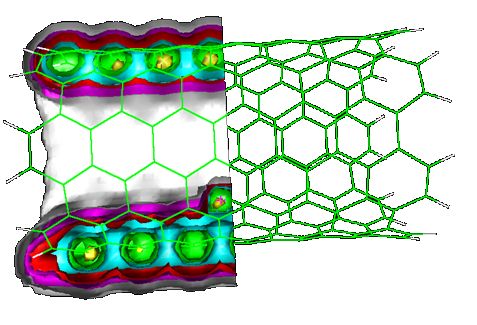Despite the intense research of carbon nanotubes over the last few decades, interest in it is not waning neither among researchers nor theoreticians. With time, the tasks are becoming even more difficult, and solving these tasks is becoming possible only for professional researchers. Associate professor of the SUSU Department of Computer Modeling and Nanotechnologies Sergey Sozykin is studying carbon nanotubes, applying various methods of modeling to them.
Associate professor of the Department of Computer Modeling and Nanotechnologies of the Institute of Natural Sciences Sergey Sozykin, candidate of physical and mathematical sciences, became one of the winners of the “Support Young Science” contest held at SUSU at the end of 2016 within the 5-100 Project with his project entitled “Modeling the Electrical and Optical Properties of Carbon Nanotubes.”
“This topic is absolutely a current one, since the area of applicant for nanotubes is quite broad. This is tied to the fact that thanks to thanks to the frame molecular structure, their properties differ them from other allotropic modifications of carbon: diamond and graphite. Carbon nanotubes are very strong, have high electrical and thermal conductivity, and can withstand stretching and bending. Thanks to this combination of such a large number of unique properties, carbon nanotubes allow us to improve the properties of existing materials and design fundamentally new ones.”
One of the simplest examples of the application of nanotubes is reinforcing materials. This is not surprising, since a molecular lattice of carbon compounds has incredible strength. The mass of the product is reduced thanks to the low density of nanotubes. More significant may be the devices using the unique electrical and optical characteristics of carbon nanotubes.

“Today the optical properties of carbon nanotubes which interact with matrixes of various forms or adsorbent materials are actively being studied. The experimental determination of the characteristics of such materials, as a rule, is expensive, and in some cases, it is absolutely impossible. For the solution of these tasks, we use computer modeling.”
In modeling objects which are not studied well experimentally, the researchers must use methods that don’t require adjustable parameters. One of them is the density functional theory, which is implemented in a number of paid and free software packages.
“Unfortunately, the power of personal computers is not enough to research realistic models of promising materials. Our competitive advantage is our access to the Tornado supercomputer, which allows SUSU researchers to solve international-level issues.”
SUSU’s scientific collectives have a lot of experience in using supercomputer technologies to solve fundamental and applied tasks. Their competitiveness is also verified by the fact that SUSU staff regularly win contests for grants on a federal level.
“At first glance, computer modeling using specialized software seems very simple. You just have to input certain parameters, and the program gives the results you need. As it turns out, there are a lot of these parameters – choosing the various combinations can take so much time that the result will already not be of interest to the scientific society. To optimize this process, you need to know chemistry and physics quite well and understand programming code. And in addition to all of this, you need to have complete mastery of English – the language of the international scientific society. For today’s schoolchildren, this probably sounds scary, but it is very possible to master these skills. You just need to make the right choice when applying to universities. I am a graduate of the Applied Mathematics and Physics track of the SUSU Faculty of Physics.”
Until now, the electronic structure of defect-free nanotubes has been studied well both theoretically and experimentally. Real nanotubes, however, have various defects in their structure. Sergey Sozykin’s project is interesting to scientific society because it takes into account these defects’ effects on the characteristics of nanotubes.
“One of the most important tasks for a theoretical researcher is to give proper prognosis of characteristics which have not yet been measured experimentally. Research typically begins with the reproduction of famous results. This allows us to assess the applicability of the chosen modeling method to the object of research. In my research, defect-free carbon nanotubes (7.7) were the object of study. Having ascertained the high accuracy of the results received, we started on the main portion of the work: determining the changes that happen within the electron structure and the spectrum of absorption for nanotubes with the introduction of defects of single and double vacancy and the Stone-Walls defect. These are new results. There has not been anything like it published openly.”
Before the completion of their project, the researchers must still solve many important tasks to achieve their main goal, for example, obtaining information about the methods of managing the electronic and optical properties of carbon nanotubes.




